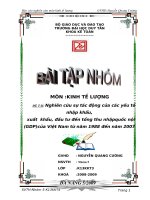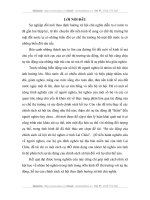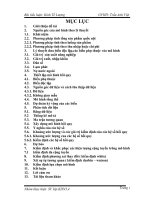Nghiên cứu sự tác động của capsaicin lên thụ thể neurokinin 1 trên tế bào lympho và tế bào mang vectơ tái tổ hợp NK 1
Bạn đang xem bản rút gọn của tài liệu. Xem và tải ngay bản đầy đủ của tài liệu tại đây (271.6 KB, 11 trang )
ĐẠI HỌC QUỐC GIA HÀ NỘI
TRƯỜNG ĐẠI HỌC KHOA HỌC TỰ NHIÊN
LÊ VĂN CAO
NGHIÊN CỨU SỰ TÁC ĐỘNG CỦA CAPSAICIN
LÊN THỤ THỂ NEUROKININ-1 TRÊN TẾ BÀO
LYMPHO VÀ TẾ BÀO MANG VECTƠ TÁI TỔ
HỢP NK-1
LUẬN VĂN THẠC SỸ KHOA HỌC
1
Hà Nội – 2015
2
ĐẠI HỌC QUỐC GIA HÀ NỘI
TRƯỜNG ĐẠI HỌC KHOA HỌC TỰ NHIÊN
LÊ VĂN CAO
NGHIÊN CỨU SỰ TÁC ĐỘNG CỦA CAPSAICIN LÊN
THỤ THỂ NEUROKININ-1 TRÊN TẾ BÀO LYMPHO
VÀ TẾ BÀO MANG VECTƠ TÁI TỔ HỢP NK-1
Chuyên ngành : DI TRUYỀN HỌC
Mã số
: 60420121
LUẬN VĂN THẠC SỸ KHOA HỌC
NGƯỜI HƯỚNG DẪN KHOA HỌC:
TS. Trịnh Tất Cường
PGS.TS. Đinh Đoàn Long
3
Hà Nội – 2015
LỜI CẢM ƠN
Tôi xin bày tỏ lòng cảm ơn sâu sắc tới TS.Trịnh Tất Cường, Phòng
Sinh học thụ thể và phát triển thuốc, Trường Đại học Khoa học Tự nhiên, ĐH
QGHN và PGS.TS.Đinh Đoàn Long, Khoa Y Dược, ĐH QGHN đã tận tình,
hướng dẫn giúp đỡ và tạo mọi điều kiện để tôi hoàn thành luận văn này.
Tôi xin trân trọng cảm ơn Phòng thí nghiệm trọng điểm Công nghệ
Enzyme và Protein đã tạo điều kiện cho tôi thực hiện luận văn trong khuôn
khổ đề tài cấp nhà nước “Nghiên cứu tạo protein thụ thể tái tổ hợp để xây
dựng mô hình sàng lọc dược phẩm” (mã số ĐT-PTNTĐ.2011-G/4)
Tôi xin bày tỏ lòng biết ơn các thầy cô giảng viên thuộc Bộ môn Di
truyền học, Khoa Sinh học, Trường Đại học Khoa học Tự nhiên, ĐH QGHN
đã hết sức giúp đỡ và tạo điều kiện cho tôi trong suốt quá trình học tập và thực
hiện luận văn.
Tôi xin chân thành cảm ơn các cán bộ nghiên cứu Phòng sinh học thụ
thể và phát triển thuốc đã luôn nhiệt tình giúp đỡ và cho tôi những lời khuyên
cũng như góp ý quý báu trong quá trình thực hiện luận văn.
Cuối cùng tôi xin chân thành cảm ơn gia đình và bạn bè đã luôn giúp
đỡ, động viên tôi trong suốt thời gian học tập và nghiên cứu.
Hà Nội, tháng 11 năm 2015
Tác giả luận văn
4
Lê Văn Cao
5
TÀI LIỆU THAM KHẢO
Tài liệu tiếng Việt
1. Vũ Triệu An (2007), Giải thưởng Nobel Sinh lý hay Y học từ năm 1901
đến năm 2007, Nxb Y học
2. Đỗ Huy Bích và cs (2004), Cây thuốc và động vật làm thuốc ở Việt
Nam, Nxb Khoa học và Kỹ thuật; 2 Tập: Tập 1 (1138 tr), Tập 2 (1255
tr).
3. Phạm Hoàng Hộ (2000), Cây cỏ Việt Nam, Nxb Trẻ, 3 tập: Tập 1 (991
trang), Tập 2 (953 trang), Tập 3 (1020 trang)
4. Văn Đình Hoa và cs (2009), Sinh lý bệnh và Miễn dịch, Nxb Y học.
5. Đỗ Ngọc Liên (2008), Miễn dịch học, Nxb ĐH QGHN.
6. Đỗ Tất Lợi (2006), Những cây thuốc và vị thuốc Việt Nam, Nxb Y học
7. Nguyễn Xuân Thắng (1998), Receptor màng tế bào và tác dụng của
thuốc, Nxb y học Hà Nội.
8. Phạm Văn Ty (2001), Miễn dịch học, Nxb Đại học Quốc gia Hà Nội
Tài liệu tiếng Anh
9. Akhil Hegde, Yung-Hua Koh, ShabbirM. Moochhala, Madhav Bhatia
(2010),
“Neurokinine-1
Receptor
Antagonist
Treatment
in
Polymicrobial Sepsis: Molecular Insights”. Int J inflame, 601098
10. Albers B., Johnson A., Lewis J., et al. (2002), Molecular Biology of the
cell. 4th edition, New York: Garland Science
11. Almeida T.A., Rojo J., Nieto P.M., Pinto F.M., Hernandez M., Martin
J.D., candenas M.L. (2004). “Tachykinins and tachykinin receptors:
structure and activity rellationships”, Bentha, Science Publishers, 11,
PP. 2045 – 2081.
6
12. Arpad Szallasi, Peter M. Blumberg (1999), “Vanilloid (Capsaicin)
Receptors and Mechanisms”, Pharmacol Rev, 51(2): 159 – 212.
13. Bjarnadóttir TK, Gloriam DE, Hellstrand SH, Kristiansson H,
Fredriksson R, Schiöth HB (September 2006). "Comprehensive
repertoire and phylogenetic analysis of the G protein-coupled receptors
in human and mouse". Genomics 88, (3): 263-73. PMID 16753280.
14. Baker S. J., Morris J. L., Gibbins I. L., “cloning of a C-terminally
truncated NK1R receptor from guinea-pig nervous system”, Brain Res
Mol Brain Res,. 11(1-2), pp. 136-47
15. ChangM. M., LeemanS. E. (1970), “Isolation of sialagogic peptide
grom bovine hypothalamic tissue and its characterization as substance
P”. J. Biol Chem, 245, PP. 4784-4790.
16. Dorsam RT, Gutkind JS. (Feb 2007). "G-protein-coupled receptors and
cancer". Nat Rev Cancer 7, 79–94.. PMID 17251915.
17. Frei A. P, Jeon O. Y., Kilcher S., Moest H., Henning L. M., Jost C.,
Pluckthun A., Mercer J., Aebersold R., Carreira EM., Wollscheid B.
“Direct identification of ligand – receptor interactions on living cells
anf tissues”
18. Fredriksson R, Lagerström MC, Lundin L-G, Schiöth HB (2003), “The
G- Protein-Coupled Receptors in the Human Genome Form Five Main
Families. Phylogenetic Analysis, Paralogon Groups, and Fingerprints”.
Mol Pharmacol 63, 1256-1272.
19. Filmore, David (2004). “It's a GPCR world”. Modern Drug Discovery
(American Chemical Society) 2004 (November): 24–28.
20. GE healthcare, instructions 71-7167-00 AG. Ficoll – Paque Plus
intended Use for invitro isolation of lymphocytes,
21. Gilman AG (1987),”G proteins: transducers of receptor-generated
signals”. Annu Rev Biochem 56, 615-649. PMID 3113327.
7
22. Jane way C.A., Traver P., Walport M., SHolomchik M. (2001),
Immunobiology, Garland Publishing, USA
23. Jian-Ping Lai, Avital Cnaan, Huaqing Zhao, Steven D. Douglas
(2008), “Detection of Full-Length and Truncated Neurokinin – 1
Receptor mRNA Expression in Human Brain Regions”, J Neurosci
Methods 168(1): 127 – 133.
24. Joel
V.
Weinstock,
Division
of
Gastroenterology-Hepatology,
Department of Medicine, University of Iowa, 4607 JPC, Iwoa City, IA
52232, USA. Neurokinin – 1.
25. Martin Beinborn, Arthur Blum, Long Hang, Tomy setiawan, Jonathan
C. Schroeder, Korynn Stoyanoff, John Leung, joel V. Weinstock.
“TGF- β regulated T – cell neurokinin – 1 receptor internalization and
function”
26. J.-P. Lai, W. Z. Ho, L. E. Kilpatrick, X. Wang, F. Tuluc, H. M.
Koechak, and S. D. Douglas (2006), “Full-length and truncated
neurokinin – 1 receptor expression and function during monocyte
macrophage differentiation”. 7771 – 7776.
27. Lefkowitz RJ, Roth J, Pastan I (1970), “Radioreceptor assay for
adrenocorticotropic hormone: new approach to assay of polypeptide
hormones in plasma”. Science 170, 633-635.
28. Levitzki A, Atlas D, Steer ML (1974) The binding characteristics and
number of beta-adrenergic receptors on the turkey erythrocyte. Proc
Natl Acad Sci USA 71, 2773-2776.
29. Lefkowitz RJ, Mukherjee C, Coverstone M, Caron M (1974),
“Stereospecific (3H)(minus)-alprenolol binding sites, beta-adrenergic
receptors and adenylate cyclase”. Biochem Biophys Res Commun 60,
703-709.
8
30. Lincy-Cain T, Bost KL (1996). Increased susceptibility of mice to
Salmonella infection following in vivo treatment with the substance P
antagonist, spantide II. J. Immunology, 157: 255-64.30.
31. Lundstrom K (2010). Expression of mammalian membrane proteins in
mammalian cells using Semliki forest virus vectors. Methods Mol Biol,
601: 149-63.
32. The royal Swedish academy of sciences (2012), “Studies of G-Proteincoupled receptors”
33. The EMBO Journal vol. 6 no.8 pp. 2255 – 2259, 1987 “Membrane –
assisted molecular of neurokinin receptor subtype selection”
34. Takeda S, Kadowaki S, Haga T, Takaesu H, Mitaku S (2002),
“Identification of G protein-coupled receptor genes from the human
genome sequence”. FEBS Lett 520, 97-101..
35. Roth BL. Receptor assay protocols. National Institute of Mental Health
– Psychoactive Drug Screening Program (NIMH-PDSP) p 305 (2013).
36. Rajani C, Jaya D, Siddiqui AA. Chemical standardization and
quantification of piperine from methanolic extract of Piper nigrum by
HPLC method on the basis of isolated markers. Int J Chem Sci (2008),
6: 1726-33..
37. Shunitz Tanaka, Toshifumi Takeuchi and Garry A. Rechnitz, “Non –
isotopic receptor assay for benzodiazepines using a biotin – labeled
ligand and biotin immobiilized microtiter plate”, Journal of
Chromatography, 597 (1992) 443 – 448.
38. Susan R. George, Brian F.O’Dowd,Samuel P. Lee. “G-protein coupled receptor oligomerization and its potential for drug discovery”
39. Venkatakrishna Rao Jala1, Brandie N Radde, Bodduluri Haribabu,
Carolyn M Klinge. “ Enhanced expression of G-protein coupled
estrogen receptor (GPER/GPR30) in lung cancer “ Jala et al. BMC
Cancer 2012, 12:624 .
9
40. Wen-Zhe Ho, Steven D. Douglas (2004), “Substance P and neurokinin
– 1 receptor modulation of HIV”. Journal of neuroimmunology,. 157 (1
– 2), pp. 48-45.
10
11









